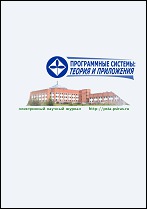|
This article is cited in 3 scientific papers (total in 3 papers)
Hardware and Software for Supercomputers
The JaSpe specializer: an algorithm of intra-procedural binding time analysis for programs in Java language subset
I. A. Adamovicha, Yu. A. Klimovb
a Ailamazyan Program Systems Institute of Russian Academy of Sciences
b Keldysh Institute of Applied Mathematics of RAS
Abstract:
A binding-time analysis in partial evaluation aimed at optimizing
programs divides software constructs into static and dynamic. A specializer
executes static constructs, and transfer dynamic ones into the resulting code.
Currently, partial evaluation is mainly used for the non-trivial compilation of
programs without a compiler, with only an interpreter and a specializer. As
previous studies have shown, the effectiveness of such an application of the partial
evaluation method significantly depends on the quality of the program annotation
obtained by performing the binding-time analysis.
The paper is devoted to the features of the binding-time analysis algorithm.
The features that arose during algorithm implementation for the widespread
object-oriented Java language within the JaSpe specializer developed by the
authors of this publication. The paper describes the basic concepts of the
binding-time analysis implemented and the intra-procedural version of the
algorithm. The article also discusses the algorithm details related to the program
constructs that use reference data types.
Apart from previous counterparts for object-oriented languages, this
algorithm non-trivially handles some language constructs: branches (if, switch),
loops (for, while, do), and block instructions that contain a sequence of other
instructions. Unlike the similar algorithms that work with imperative and
functional languages, the considered algorithm uses the BT-objects, which allow
specializer to obtain more accurate annotation (with a higher fraction of static
constructs) when processing object-oriented programs. Another feature of this
algorithm is the focus on interactivity and readability of results.
Key words and phrases:
modern programming languages, static program analysis, program transformation, metaprogramming, mixed computation, interactive specialization.
Received: 17.01.2020
Accepted: 20.02.2020
Citation:
I. A. Adamovich, Yu. A. Klimov, “The JaSpe specializer: an algorithm of intra-procedural binding time analysis for programs in Java language subset”, Program Systems: Theory and Applications, 11:1 (2020), 3–29
Linking options:
https://www.mathnet.ru/eng/ps360 https://www.mathnet.ru/eng/ps/v11/i1/p3
|

| Statistics & downloads: |
| Abstract page: | 123 | | Full-text PDF : | 50 | | References: | 18 |
|




 Contact us:
Contact us: Terms of Use
Terms of Use
 Registration to the website
Registration to the website Logotypes
Logotypes








 Citation in format
Citation in format 
